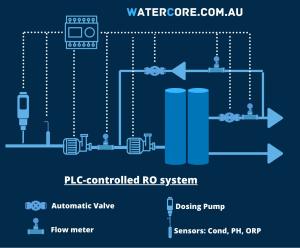How To Overcome Feedwater Changes In Reverse Osmosis Systems
All Watercore Reverse Osmosis desalination units incorporate a PLC that controls all key performance parameters, increasing production capacity and efficiency
All Watercore Reverse Osmosis desalination units incorporate a PLC that controls all key performance parameters, increasing production capacity and efficiency”
EDGECLIFF, NSW, AUSTRALIA, November 10, 2020 /EINPresswire.com/ -- 1. INTRODUCTION— David Garcia
Feedwater analysis has always been the most important criterion to design and estimate the performance of Reverse Osmosis plants. It is also one of the first things to check when plant performance deteriorates.
In environments where feedwater salinity is irregular, design and performance can not rely on analysis made months or years ago, and water can not be tested every day.
Typical effects of salinity changes in reverse osmosis feedwater are:
-Higher salt content: Higher osmotic pressure – lower permeate production
-Lower salt content: Lower osmotic pressure – higher permeability – lower crossflow velocity
-Change in ionic balance (e.g. more hardness, more chloride): Higher Calcium Carbonate scaling risk, higher Chloride concentration in the permeate
2. HOW CAN CROSS-FLOW VELOCITY IMPACT THE MEMBRANE PERFORMANCE AND LIFE?
To reduce the membrane fouling rate in reverse osmosis plants, RO systems use cross-flow filtration. Cross-flow makes the water sweep the rejected salts away from the membrane surface while a portion of the feedwater permeates the membrane to form the permeate flow.
Cross-flow velocity can be calculated by taking the feed flow rate divided by the cross-sectional area of feed channel spacer and is a key factor in the reverse osmosis plant performance and fouling potential.
Depending on the element size and type, reverse osmosis membranes have a minimum concentrate flow rate and maximum feed flow rate. Operating within these minimum and maximum flows is important to prevent damage to the membrane and obtain high membrane performance. Flows outside those limits will have a negative impact on the membrane life.
To avoid excessive concentration polarization at the membrane surface, the recovery rate per membrane should not exceed 18%. However, it is common engineering practice to design brackish RO systems in a way that the average membrane recovery is about 9%.
Reverse osmosis systems operate best when permeate and concentrate flows (and therefore, recovery of the system) are held constant. These variables are important to minimize fouling and scaling of the RO membranes.
3. AUTOMATIC VS. MANUAL CONCENTRATE-FLOW CONTROL VALVES
This ratio between concentrate and permeate flows is the main driver of the cross-flow velocity, hence an accurate control of the concentrate valve is decisive for the overall reverse osmosis performance and membrane life. Nevertheless, as previously, any adjustment will be dependant on the feedwater salinity and will have to adapt to such variations.
In most small and medium-size reverse osmosis systems, the ratio between permeate and concentrate flows is controlled by a manual concentrate valve which is adjusted during commissioning and re-calibrated at every scheduled service.
This manual configuration is acceptable when feedwater quality is consistent, with no significant variation in the feedwater salinity and composition. However, in many commercial and industrial applications, feedwater salinity is very unpredictable and inconsistent with frequent and significant variations. This variations are common due to several reasons:
-Cooling and other industrial proceses are not uniform
-Underground water sources, which are often the RO feedwater, present remarkable seasonal salinity variations
The main consequence of these feed water salinity changes is the need for constant re-adjustments of the concentrate valve, which is not feasible when such control is manual.
Automatic concentrate-valve control will automatically adjust concentrate and permeate flows to achieve the desired average membrane recovery regardless of the feedwater salinity, hence producing suitable cross-flow values.
When operating conditions change, i.e., when the feed water salinity changes, temperature decreases or membrane fouling occurs, performance parameters such as the permeate flux also change and automatic adjustment of the concentrate valve can bring the system back to optimum performance.
4. HOW IS THE AUTOMATIC CONCENTRATE-VALVE CONTROLLED?
In our case, all Watercore RO desalination units incorporate a PLC pre-programmed to execute all central control tasks required in the RO plant.
Based on a modular approach, the PLC controls the concentrate valve, the recirculation valve, the by-pass valve as well as the pressure and dosing pumps based on readings from different digital sensors.
This PLC-control offers a number of benefits:
-Simplified commissioning protocol
-Reduced operational and maintenance tasks
-Flexible feedwater quality
-Extended membrane life
-Admits multiple additional plug-and-play sensors (ORP, PH, Cond, etc)
5. CAN ANY EXISTING RO SYSTEM BE UPGRADED WITH AN AUTOMATIC CONTROL?
Yes, any existing reverse osmosis plant can be upgraded with this feature. Renovation is possible, keeping most of the RO system (pumps and membranes) intact. This simplifies the process and reduces down-time.
Modern electronic flow sensors will need to be installed, the electric panel will have to be updated and in most cases these works can be carried-out in a very short period.
These upgrades bring additional benefits such as:
-Automatic control and remote supervision
-Reduction of operational costs
-Increased production capacity and efficiency
-WHS improvements
6. CONCLUSIONS
Feedwater analysis has always been the most important criterion to design and estimate the performance of Reverse Osmosis plants, however it is common to find unpredictable and inconsistent feeedwater salinity with frequent and significant variations.
Automatic concentrate-valve control will automatically adjust and optimise key performance parameters increasing the reverse osmosis membrane life.
David Garcia
Watercore
+61 1300 742 010
email us here
Visit us on social media:
Facebook
Twitter
LinkedIn



